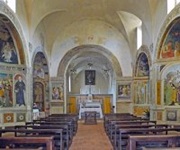


In 1271, Damiano di Bengente built a hermitage here for his daughter Joanna, the sister of St Clare of Montefalco, so that she could form an eremitical community of women. St Clare joined her in 1274, when she was only six years old. In 1281, Joanna, Clare and some of their sisters moved to what became the convent of Santa Croce (now Santa Chiara da Montefalco).
Some of the women remained behind at the original hermitage, and Cardinal Napoleone Orsini institutionalised them under the Rule of St Augustine in 1302. They built the first church here in 1304. In 1480, when the community had dwindled to only three sisters, Bishop Constantino Eroli moved it to Santa Croce.
The fortunes of the church revived in 1491, when Anselmo da Montefalco became the general of the Augustinian Order. He transferred the convent to a reformed community of Augustinian friars of the Lomdard Congregation, who rebuilt the church. The community was suppressed in 1653, and the church was passed to the Collegiata di San Bartolomeo.
A community of Capuchins occupied the convent in the period 1910-75.
The façade has an imposing portico of three arches.
Interior

The interior has a single nave with three chapels on each side. The surviving frescoes are important examples of early 16th century art in Montefalco, albeit that they are in need of restoration.
Frescoes by or Attributed to Francesco Melanzio
The fresco from Sant’ Illuminata by or attributed to Francesco Melanzio include:
-
✴frescoes (1507) in the 2nd chapel on the right, which are dated by inscription, that depict:

-
•the Assumption of the Virgin;
-
•SS Agatha and Augustine, on the left;
-
•SS Gregory and Lucy, on the right; and
-
•the Coronation of the Virgin and the four Evangelists, in the dome.
-
✴frescoes (ca. 1507) in the 2nd chapel on the left, which depict:

-
•the Nativity;
-
•St Martin and the flight to Egypt, on the left;
-
•the Epiphany and St Nicholas of Tolentino, on the right; and
-
•the Holy Spirit with angels, in the dome.
-
✴a fresco (1509) to the right of the presbytery, which is dated by inscription, that depicts the Pietà with the Virgin and St Mary Magdalene; and

-
✴frescoes (1515) in the 3rd chapel on the right, which are signed and dated by inscription, that depict:

-
•the Madonna and Child enthroned;
-
•SS Sebastian and Laurence, on the left;
-
•SS Jerome and Antony Abbot, on the right; and
-
•the the Resurrection, in the dome.
-
Francesco’s nephew, Febo Melanzio was recorded with him in a document notarised in the cloister of Sant’ Illuminata in 1515, which suggests that he might also have worked on these frescoes.
Frescoes (1507)

-
✴the Madonna and Child enthroned;
-
✴SS Roch, Sebastian, Nicholas of Tolentino and Augustine, on the left;
-
✴St Clare of Montefalco, Blessed Joanna and SS Catherine of Alexandria and Illuminata, on the right; and
-
✴angels throwing flowers, in the dome.
Frescoes (early 16th century)

-
✴the martyrdom of St Catherine of Alexandria;
-
✴SS Antony of Padua and Jerome, on the left;
-
✴SS John the Baptist and Nicholas of Tolentino, on the right; and
-
✴God the Father with angels, in the dome.
Art from the Church
The following are in the Pinacoteca:
Madonna and Child (ca. 1470)
The panel in Montefalco is generally dated in relation to the (now lost) copy of this icon that Alessandro Sforza, lord of Pesaro commissioned from Melozzo da Forli in ca. 1470. There is some debate about its attribution:
-
✴It is usually thought, on stylistic ground, to be another copy by Melozzo da Forli or his workshop.
-
✴However, yet another copy of the icon that was in the Charles Loeser Collection, Florence until 1959 is generally attributed to Antoniazzo Romano, who was a prolific painter of this kind of image (as set out in the page on this artist). Federico Zeri attributed the panel in Montefalco to him.
-
✴Laura Teza has recently suggested, on stylistic ground, that it is by the Perugian, Bartolomeo Caporali, who was documented in Rome in 1467 among the artists working for Pope Paul II at the Chiesa di San Marco (as referenced in the page on this artist).
[The image in this Hungarian website has obvious relevance to the debate, but I have not been able to find out anything else about it.]
Three Saints (ca. 1488)

The altarpiece depicts three saints who are identified by inscription as SS Vincent of Saragossa, Illuminata and Nicholas of Tolentino. Recent restoration has shown that these inscriptions are not original and that:
-
✴the central figure of “Sant’ Illuminata” originally had a wheel (later over-painted but revealed in the restoration), and so had been adapted from an image of St Catherine of Alexandria: and
-
✴“St Nicholas of Tolentino” originally had a Franciscan habit that had been over-painted, and so had been adapted from an image of a Franciscan, probably St Antony of Padua.
This over-painting was almost certainly done at the time that the panel was transferred to Montefalco.
The presence of St Catherine of Alexandria at the centre of the composition suggests that the altarpiece was painted for an altar dedicated to her. The Portuguese Cardinal Jorge Costa, who had bought the Cappella di Santa Caterina in Santa Maria del Popolo from Cardinal Domenico della Rovere in 1488, almost certainly commissioned it: this probably accounts for the presence of two Iberian saints (SS Vincent of Saragossa and Antony of Padua). The panel was probably transferred to Montefalco after the death of Cardinal Costa in 1508.





